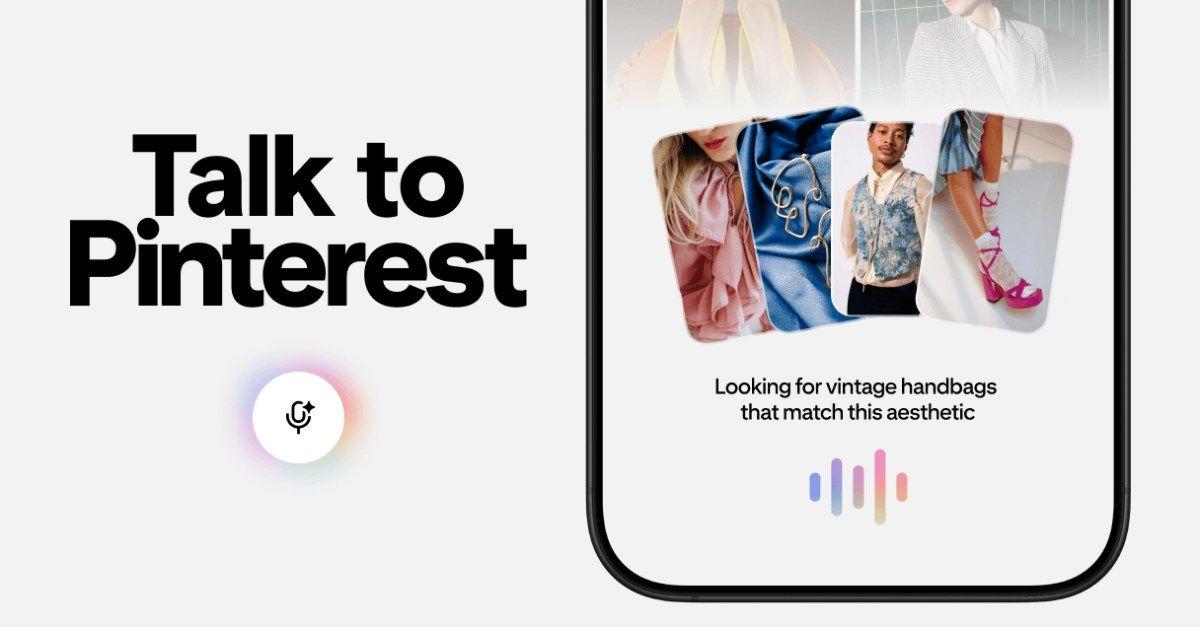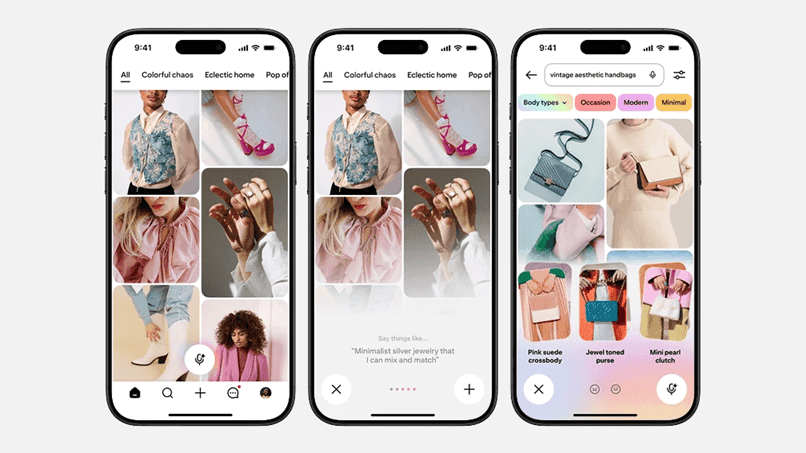Pinterest Launches AI Shopping Assistant While Embracing Open Source Models to Cut Costs
6 Sources
6 Sources
[1]
Pinterest CEO touts open source AI: 'tremendous performance' with reduced costs | TechCrunch
On an earnings call on Tuesday, Pinterest CEO Bill Ready highlighted the promise of open source AI models in helping the company keep its costs down as it expands the use cases for visual AI. The image pinboarding site, which often serves as consumers' first step in their shopping journey, leverages AI technology to power a variety of features, including its personalized recommendations, a multimodal search experience that combines text and images, ad targeting, and, most recently, product discovery with the launch of its AI-powered Pinterest Assistant. However, investors wanted to know what Pinterest's opportunity in agentic commerce -- AI systems that can act autonomously on behalf of users -- was given the rapidly changing AI landscape, and how that could impact its bottom line and growth potential. That question has become more pressing. During the company's third-quarter earnings announcement, it predicted a weaker holiday shopping season than expected, citing President Donald Trump's tariffs and their negative impact on the home furnishings category. As a result, Pinterest's fourth-quarter revenue is expected to come in between $1.31 billion and $1.34 billion, while analysts were estimating $1.34 billion, on average. The news sent the stock tumbling by more than 21% on Wednesday. Despite the near-term revenue concerns, Pinterest CEO Bill Ready pointed to ways the business could maximize its use of AI and LLMs (large language models), without dramatically increasing its costs. In addition to its own proprietary models that are already accounted for in its cost structure, Ready said the company tests leading off-the-shelf models against open-source options on a regular basis, and found the open-source models promising. "One of the really, really interesting things that we're seeing is that we are just getting tremendous performance from open source models specifically for Pinterest use cases on visual AI," Ready told investors. "Given current market rates and per token costs, in early testing, we're seeing orders of magnitude reduction in cost with comparable performance using fine-tuned open source models versus leading off-the-shelf proprietary models." He said the company planned to move forward with many open-source models for its various use cases, which would come at "a fraction of the cost" of the larger model providers. "We feel really good about the value that we're bringing to the user there, our ability to align that with monetization, and our ability to control those costs and deliver that effectively," said Ready. The exec also touched on other areas where Pinterest is considering how to best use AI, including agentic shopping. Ready said that Pinterest already offers "push-button type buying" via its Amazon partnership, and it will wait to see if users actually want the AI to "push the button for them." In the meantime, Ready suggested that Pinterest's biggest differentiator is that it guides the user through the shopping experience -- something it hopes to improve with Pinterest Assistant, an AI companion users can talk to, asking for advice and recommendations. The assistant understands the user based on their boards, collages, saves, and how they compare to people with similar tastes, the company says. Pinterest is also rolling out personalized boards curated with AI, which Ready said combine expert human curation and AI.
[2]
Pinterest's new shopping assistant finds products to fit your tastes - see how it works
The feature is available to US users aged 18 and above, with wider availability to follow. Instead of spending hours scrolling through your Pinterest feed looking for the perfect decor inspiration, outfit idea, nail set, or tattoo idea, you can ask Pinterest's new AI-powered assistant to find exactly what you're looking for. Also: Not sure what to buy? Amazon's latest shopping tool can help you decide - here's how it works Pinterest Assistant uses your saves, boards, collages -- and those of other users with similar tastes -- to find posts that match your interests and style. According to Pinterest, Pinterest Assistant differs from other chatbots because users don't need to know what they're looking for to find it. Instead, Pinterest Assistant offers "visual, personalized and proactive recommendations." Pinterest says it gathers information from users' interests to feed its visual discovery tool called Taste Graph, which provides AI-powered recommendations to users. Pinterest claims its AI shopping assistant is "visual-first," utilizing real-time, conversational descriptors to deliver personalized recommendations to shoppers. To more closely replicate real-life shopping experiences, users can verbally relay their requests to Pinterest Assistant. For example, Pinterest says, users can ask the Assistant questions like, "Show me holiday party dresses that fit my style." Pinterest Assistant is available in beta to users aged 18 and above in the US. Wider availability is planned for the coming weeks and months, according to Pinterest. Pinterest isn't the only online shopping platform to explore AI-powered search results, making shopping easier for customers. Amazon Lens enables users to point their camera at a product and receive similar products listed on Amazon, as well as suggested questions and product summaries. Another Amazon shopping tool uses AI to curate recommended items based on your shopping history and personal preferences. Also: Your Uber driver has a new side hustle: Training AI for cash Walmart and Sam's Club recently announced a partnership with OpenAI to integrate ChatGPT into shoppers' shopping experiences, offering personalized item recommendations and grocery list planning. Get the morning's top stories in your inbox each day with our Tech Today newsletter.
[3]
Pinterest's new AI shopping assistant helps you pick a fit
Move over Andy Sachs, Pinterest is launching an AI-enabled shopping assistant that aims to suggest your next look. Beginning on Thursday, and over the coming weeks and months, Pinterest users will be able to talk to the visual platform about what they're shopping or searching for. The Pinterest Assistant will come back with personalized recommendations based on the user's saved collections and whatever pins are currently up on their screen, and briefly narrate the results. The AI assistant is meant to encourage a more conversational experience, Pinterest CEO Bill Ready told The Verge. This is why the assistant only accepts voice inputs from users -- and why the assistant will talk back to users when it provides the suggested pins and products. (For now, you cannot turn off the audio narration.) The AI assistant is an optional feature that is not a replacement for traditional text-based search, which remains unchanged on the platform. Pinterest already uses AI to curate its recommendations to users, Ready said. The voice layer is the new addition to the text and image AI model. "What we're doing now is making it so that you can actually have a conversation with that," he said. During Ready's roughly three-year tenure, the platform has "effectively become an AI-powered shopping assistant for our nearly 600 million users," he said, more than half of whom are Gen Zers. The company attracted criticism earlier this year for allowing AI-generated slop to flood the platform. In response, Pinterest began labeling AI-generated images as such and launched a "tuner" feature for users to select categories, like fashion or beauty, that they want populated with less AI-generated content. Ready said that users are asking longer queries containing more information, which he sees as an indication that they want a more unstructured way of interacting with the platform. A Taylor Swift fan who likes knitting, for example, might not know what they're looking for or take the time to type out a vague vision, Ready said. "But when it's conversational, you see people speak very differently than they would type." Users can talk to the assistant by holding down the mic button, similar to sending a voice note to a friend. During a demo to The Verge, Pinterest's director of AI products Ryan Galgon asked the assistant to come up with fashion suggestions based on a Wimbledon poster image. Images of tennis-style outfits appeared on the screen, which the assistant verbally described before offering to search for more preppy or more casual ways to style the fit. Pinterest purposefully chose to keep the audible response concise with a brief description of the recommended pins, Galgon said. The goal is to maintain an experience that is "really grounded in visuals," he said. The Pinterest Assistant is powered by a "multimodal" AI model that is "visual-first." This means that the model can process audio, image, and text, and its output is images. Ready said that the core AI model is built in-house with proprietary "signal" data from users. It also includes some off-the-shelf AI models for basic language processing. Adult US users can now sign up to get access to a beta version of the new AI feature, which the company says will be made widely available over the next few weeks and months.
[4]
Pinterest has its own AI assistant now
Pinterest is adding a new way to find clothes, furniture and other sources of aesthetic inspiration through its app. It's called Pinterest Assistant, and it's an AI-powered search and recommendation tool that uses knowledge of your Pinterest activity to tailor its responses. Whereas other search features work best when you have a specific thing you're looking for in mind, Pinterest says the Pinterest Assistant is meant to handle more open-ended requests. Asking for pillows that match your "living room decor" is supposed to be enough for the AI to surface interesting results. To do that, the Pinterest Assistant looks at the items you've saved and the boards you've created (for example, a board full of living room decor inspiration), compares it with the things Pinterest users with similar taste have saved and displays visual results tailored to you. Pinterest appears to be specifically interested in the multimodal aspect of this new feature. The main way the company imagines you'll interact with Pinterest Assistant is via a mic icon in the Pinterest app that starts a voice search. The AI assistant then takes that audio prompt and uses it to filter and analyze visual content to find the best fit. Besides surfacing items you might not have found on your own, Pinterest says the whole process should be "closer to how people shop in real life." Rolling out its own AI features puts Pinterest in an interesting place when it comes to AI content on its platform. Users have complained that the growing amount of AI-generated material on Pinterest has made it hard to find real things to buy or add to a board. In May, the company started labeling AI content in the app to make finding real items easier, and earlier in October it added a way to "dial down" the amount of AI generated content users see in the app. Pinterest Assistant isn't necessarily a solution for an AI slop problem the company is struggling to solve, but it might help users who are sick of sifting through AI content anyway. Pinterest Assistant begins rolling out in beta today to users in the US who are 18 and over, with wider availability coming in the next weeks and months.
[5]
Pinterest's 'AI Everywhere' Strategy Drives User, Search Growth | PYMNTS.com
By completing this form, you agree to receive marketing communications from PYMNTS and to the sharing of your information with our sponsor, if applicable, in accordance with our Privacy Policy and Terms and Conditions. Ready said Pinterest's mission is to "anticipate what users will love next," describing how the company's AI systems are designed to predict inspiration before users even search. "Unlike chat or search platforms that wait for users to type a prompt, our AI curates inspiration that's ready the moment they return." Third-quarter revenue rose 17% to $1.049 billion, slightly ahead of Wall Street expectations, according to the company's earnings report for the period ending Sept. 30. Monthly active users climbed 12% to 600 million. Ready said all users logged in are generating "billions of first-party intent signals" that train its recommendation systems. The company processed 80 billion monthly queries in the third quarter, up 44% from a year earlier. Visual search drives most of that growth, and users are conducting more searches per session, signaling deeper engagement and stronger commercial intent. Pinterest launched its first multimodal search tool in May, starting with women's fashion. The feature combines text and image inputs for more precise results and will expand to more categories in 2025. The company is also testing a voice-based Pinterest Assistant that converts open-ended prompts like "what outfits match this theme" or "make these home ideas brighter" into curated visual results. Ready said this combination of first-party data and personalization gives Pinterest "a distinct right to win" in visual discovery. "As we provide more value to our users by surfacing what they're looking for, they engage more deeply," he said. Pinterest credited AI with lifting engagement per user faster than total user growth. Yet the scope of its features, spanning shopping, conversational search, recommendation, and advertising, raises questions about cost and focus. "We see a clear path to sustainable growth," Ready said, "but AI is the heart of that experience, and it comes with higher infrastructure investments." Pinterest's embrace of AI is part of a growing trend that sees retailers increasing investments in the technology. PYMNTS Intelligence data shows that 73% of retailers plan to increase their investments in gen AI over the next year to be able to analyze transactions and payments data. Visual search scale: Queries climbed 44% year over year to 80 billion monthly searches, reinforcing Pinterest's role as a visual discovery engine. Agentic commerce: Ready said the platform now guides users through "decision-making journeys." Purchases still occur off-site, but users with Amazon-linked accounts can move directly from a shoppable pin to Amazon's checkout page in near one-click fashion. Holiday engagement push: The Holiday Edit campaign anchors Pinterest's fourth-quarter strategy. Hundreds of AI-assisted gift boards pair algorithmic suggestions with human editors across 17 categories such as fashion, home, beauty, travel and technology. Ad performance: Outbound clicks to advertisers rose 40% in Q3, showing tighter alignment between product discovery and commerce. Advertising remains Pinterest's primary source of revenue. Total operating costs rose as the company invested in AI models and infrastructure. Net income was $6 million, compared with a $65 million loss a year earlier. Global average revenue per user was $1.78, with the United States and Canada reaching $7.64. International users represented 83% of Pinterest's total audience but accounted for just 25% of revenue, underscoring the company's ongoing monetization gap outside North America. Pinterest expects fourth-quarter revenue between $1.313 billion and $1.338 billion, implying growth of 14% to 16% year over year. The company reaffirmed its goal of mid-to-high teens revenue growth while cautioning that infrastructure spending will continue to rise as AI usage expands.
[6]
Pinterest Launches AI Shopping Assistant and Gen AI Controls | PYMNTS.com
The new Pinterest Assistant uses AI to help users find products and ideas that match their tastes, expanding the platform's long-standing focus on inspiration into one centered on action. The company said the update is designed to make Pinterest "a more actionable destination," unifying search, personalization and shopping within a single experience. Complementing the Assistant, Pinterest also announced AI-powered upgrades to its boards that generate tailored recommendations based on each user's activity and saved Pins. New features such as "Make It Yours," "More Ideas," and "All Saves" are being introduced across the United States and Canada, with "Boards Made for You" and "Styled for You" in testing. The company said the new experience will use AI to curate fashion, décor and lifestyle products that match each user's interests, making it easier to act on ideas by bringing inspiration and shopping into one place. Product Pins continue to connect directly to retailer sites, allowing users to move from discovery to purchase without leaving the platform's shopping environment. CEO Bill Ready said Pinterest's evolution reflects a deeper alignment between discovery and decision-making. "People come to Pinterest with intent," Ready said. "They arrive looking for ideas, and our job is to help them take action on that inspiration." The company reported more than 600 million monthly active users as of mid-2025. During Pinterest's second-quarter 2025 earnings call, Ready said the platform "has effectively become an AI-enabled shopping assistant," underscoring how artificial intelligence is now central to its growth strategy. Ready added that AI is powering every stage of the Pinterest experience, from personalized recommendations to shoppable search results, positioning the company to better connect intent-driven users with products they are ready to buy. Pinterest's move to AI-assisted shopping reflects a larger push among consumers to embrace the technology. A recent PYMNTS Intelligence survey showed that almost half of consumers want AI help with shopping. Those numbers jump dramatically for the younger generations. Other brands are also adopting AI tools to assist consumers in the shopping experience. Pinterest is also taking aim at the flood of synthetic media shaping online experiences. The company said roughly 57% of all content circulating on the internet now contains some degree of AI modification. To maintain clarity and control, Pinterest rolled out an AI tuner that lets users adjust how much generative content appears in their feeds. Through the tuner, users can customize their exposure to AI content across categories such as fashion, home decor and beauty. Pins that are created or altered by AI now carry an "AI-modified" label, while an updated "See fewer like this" feature allows users to refine what appears in their home feed. Pinterest said these controls were designed to "give people more context and choice" without limiting discovery. "Our community is at the heart of everything we do," said Matt Madrigal, chief technology officer. "With our new gen AI controls, we're empowering people to personalize their Pinterest experience more than ever, striking the right balance between human creativity and AI innovation, and ensuring every feed truly reflects what inspires them most."
Share
Share
Copy Link
Pinterest introduces its new AI-powered shopping assistant that provides personalized recommendations through voice interactions, while CEO Bill Ready highlights the company's strategic shift toward open source AI models to achieve significant cost reductions.
Pinterest Unveils AI Shopping Assistant with Voice-First Experience
Pinterest has launched its new AI-powered shopping assistant, marking a significant expansion of the visual platform's artificial intelligence capabilities. The Pinterest Assistant, now available in beta to US users aged 18 and above, represents the company's effort to transform how users discover and shop for products through conversational AI
1
3
.The assistant operates through voice interactions, requiring users to hold down a microphone button to ask questions like "Show me holiday party dresses that fit my style" or "what outfits match this theme." Unlike traditional text-based search, the AI tool provides personalized recommendations based on users' saved collections, boards, and collages, as well as data from users with similar tastes
2
4
.
Source: The Verge
Open Source Strategy Delivers Major Cost Savings
During Pinterest's third-quarter earnings call, CEO Bill Ready highlighted a strategic shift toward open source AI models that has yielded impressive financial results. The company has been testing leading proprietary models against open-source alternatives and discovered significant cost advantages without sacrificing performance quality
1
.
Source: TechCrunch
"We are just getting tremendous performance from open source models specifically for Pinterest use cases on visual AI," Ready told investors. "In early testing, we're seeing orders of magnitude reduction in cost with comparable performance using fine-tuned open source models versus leading off-the-shelf proprietary models"
1
.This cost optimization strategy comes at a crucial time for Pinterest, as the company faces revenue headwinds. Fourth-quarter revenue is expected to reach between $1.31 billion and $1.34 billion, slightly below analyst expectations, partly due to concerns about tariff impacts on the home furnishings category
1
.Strong User Engagement and Search Growth
Pinterest's AI investments are paying dividends in user engagement metrics. The platform processed 80 billion monthly queries in the third quarter, representing a 44% increase year-over-year. Monthly active users climbed 12% to 600 million, with the company describing how all logged-in users generate "billions of first-party intent signals" that train its recommendation systems
5
.
Source: PYMNTS
The company's multimodal search capabilities, launched initially for women's fashion in May, combine text and image inputs for more precise results. Visual search drives most of the query growth, with users conducting more searches per session, indicating deeper engagement and stronger commercial intent
5
.Related Stories
Technical Architecture and Competitive Positioning
The Pinterest Assistant utilizes a "multimodal" AI model that processes audio, image, and text inputs while maintaining a "visual-first" approach. The core AI model combines proprietary in-house technology built from user signal data with off-the-shelf AI models for basic language processing
3
.This technical approach differentiates Pinterest from other AI shopping platforms. While Amazon offers Lens for visual product search and Walmart partners with OpenAI for ChatGPT integration, Pinterest's assistant leverages the platform's unique position as a visual discovery engine with deep personalization data
2
.The company has also addressed concerns about AI-generated content flooding the platform by implementing content labeling and allowing users to "dial down" AI-generated material in their feeds
4
.References
Summarized by
Navi
[1]
[4]
Related Stories
Pinterest CEO Downplays Agentic Shopping, Emphasizes AI-Enabled Assistance
09 Aug 2025•Business and Economy

Pinterest Enhances Visual Search with AI-Powered Features for Personalized Shopping Experience
06 May 2025•Technology

Pinterest's AI-Powered Ad Tools Drive Strong Q4 Results and Optimistic Forecasts
07 Feb 2025•Business and Economy

Recent Highlights
1
OpenAI releases GPT-5.2 AI model after code red memo targets Google's Gemini 3 threat
Technology

2
Disney invests $1 billion in OpenAI, licenses 200+ characters for Sora AI video generator
Technology

3
OpenAI faces wrongful death lawsuit after ChatGPT allegedly fueled murder-suicide tragedy
Policy and Regulation





